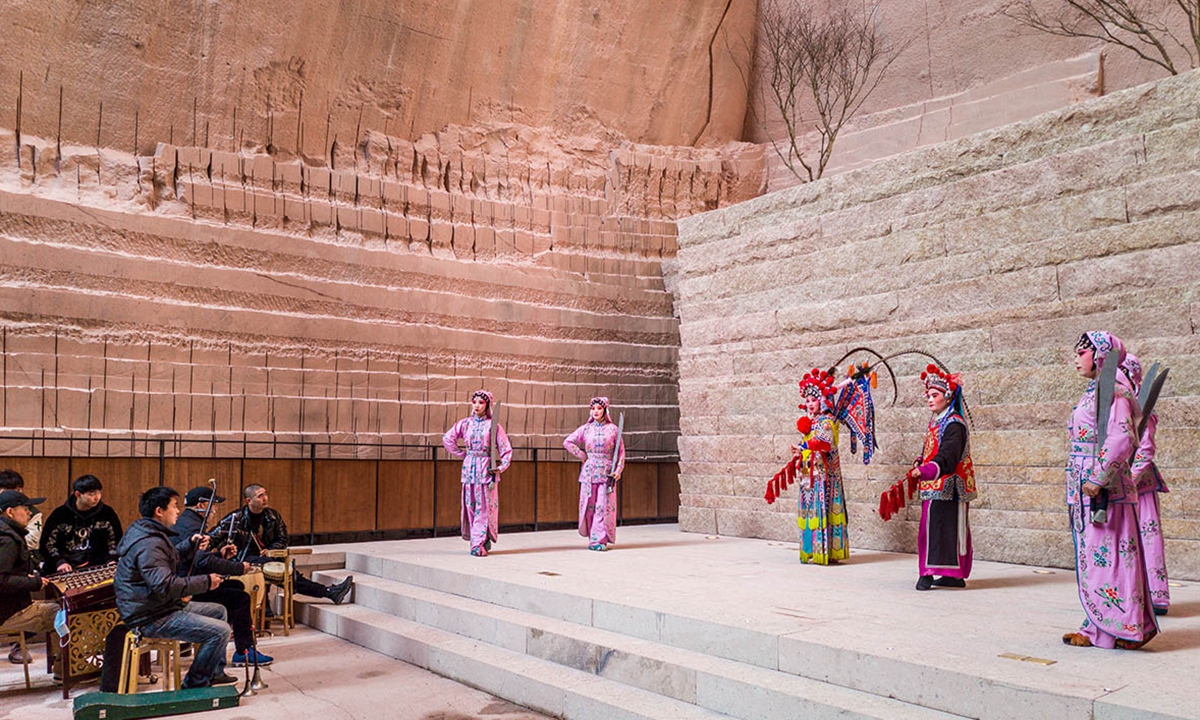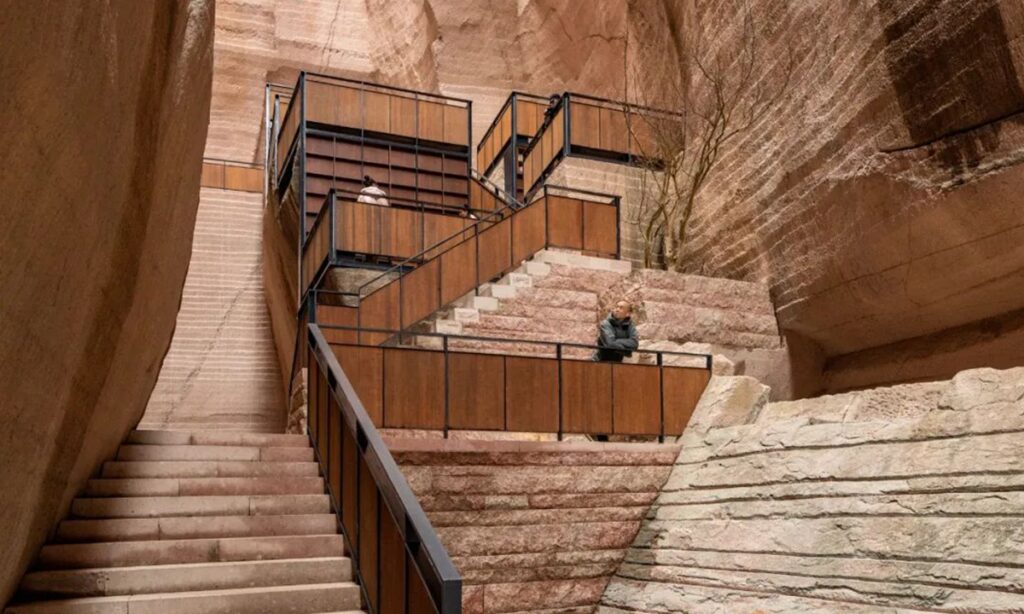
Performance in Quarry 9, transformed by an abandoned mine in Jinyun in East China’s Zhejiang Province. The porous rock material and 36-meter-high walls make the quarry a natural concert hall with good acoustics. Photo: Courtesy of DnA_Design and Architecture
A recent exhibition in Berlin featured a rather unusual item: abandoned mines in a village in East China. The local government and architects are now trying to transform the ancient mines into eco friendly spaces that can be used for modern purposes.
Since around 1,300 years ago, local people in Jinyun, East China’s Zhejiang Province, have been making a living from quarrying tuff, a soft, porous type of rock made of volcanic ash that can be used for construction. From around 1960 to 1970, the massive exploitation of local stone quarries caused damage in the landscape.
“When you walk on the streets in Jinyun, you can see that many old buildings, bridges, and the roads under you are in fact made of tuff that local people quarried themselves. In old times people here also sent tuff around the country, making it an industry,” a local tourist guide in his 30s surnamed Liu told the Global Times on Tuesday. “They call this place a city of rock.”
The locals said that ever since Jinyun became a large-scale production base for rock mining, there have been more and more quarries where hundreds of people could be seen mining together. “The scene was really spectacular.” But now, over 3,000 quarries of varying sizes have been left abandoned in the outskirts of Jinyun.
Liu said his grandparents told him that in the mining at that time “casualties were common. Loud noises could be heard when a large chunk of rock suddenly fell, accompanied by a small landslide.”
Out of environment and safety concerns, the mines in Jinyun were gradually shut down at the end of the last century. Now the local government has started a transformation process for this “artificial heritage.”
Eco-restoration action
From Buddhist grotto statues to large-scale hotels, the local government has been coming up with ways to reuse the deserted mines, but a lot of the plans have been aborted for various reasons such as the large amount of investment required.
“We received an invitation from the local government to do research about the mines in April 2021. Eventually we came up with a practical scheme to retain the original appearance to the greatest extent and reduce human intervention,” architect Xu Tiantian from DNA_Design and Architecture told the Global Times on Sunday.
The primary consideration is security. In the first nine mines that Xu and her team chose for the project, they got tunnel companies to conduct geological inspections for reinforcement work. “Later these reinforced surfaces actually became the new texture of the grottoes,” said Xu.
Based on planning by the local government and the team, the project has been launched as an ecological restoration action. By reconstructing the mines in a safer and more splendid state, their economic and social value can also be restored.
Taking quarry number nine as an example, its porous rock material and 36-meter-high walls make it a natural concert hall with good acoustics. It can also be used as a theater.
Other quarries have various functions, such as former mining workers demonstrating the quarrying process, or platforms allowing visitors a good view of the sunset.
“Things like quarries are art in the Earth. We adopt an approach where we nail down each of the quarries’ public functions based on their characteristics, which not only ensures safety, but also lowers costs and the time required,” Xu said.
Make full use
However,the local government are now still facing challenges in making full use of the venues in order to ensure the sustainable development of this place.
Hu xiongjun, a local official, told the Global Times that most of the local people, no matter the retired miners or the young people, in fact support the reconstruction of the mines, which have attracted quite a few tourists since they were opened.
“For local people, the transformation also brings a change in their way of life. In the past we mainly relied on quarrying for a living, but now we rely on tourism, with a string of sidelines including hotels, home stays and restaurants,” Hu told the Global Times.
Some artists have come to hold exhibitions in the mines, but more cooperation plans and performance projects are needed.
“These mining areas are located in relatively remote places, so attracting performance groups is still a challenge,” Hu added.
Quarry 8 is tranformed into a library from an abandoned mine in Jinyun in East China’s Zhejiang Province, which has attracted many visitors to appreciate. Photo: Courtesy of DnA_Design and Architecture




